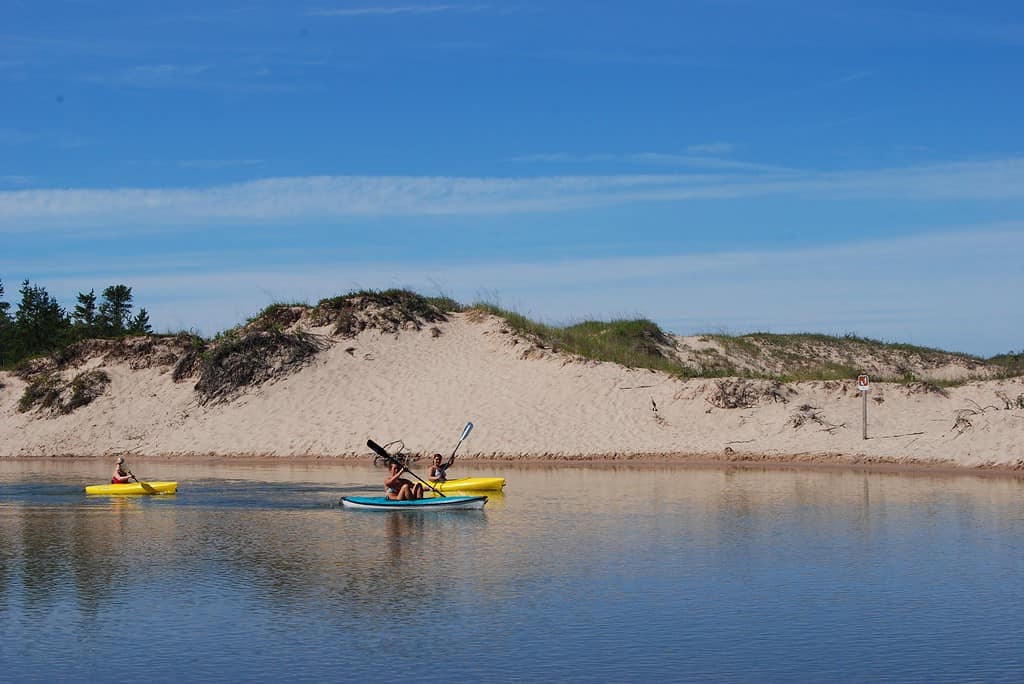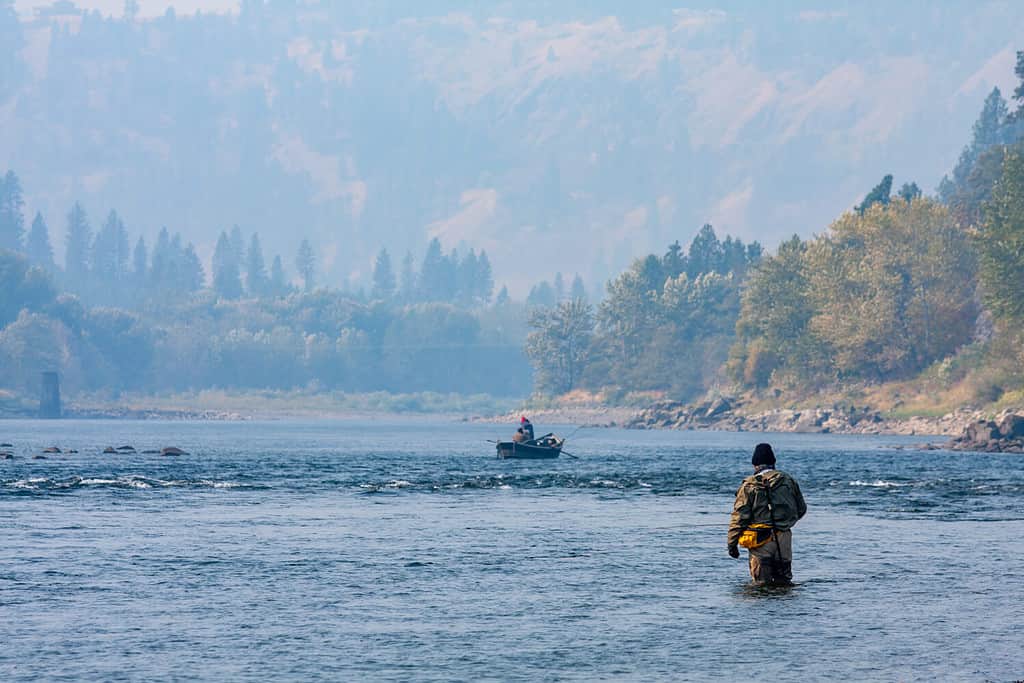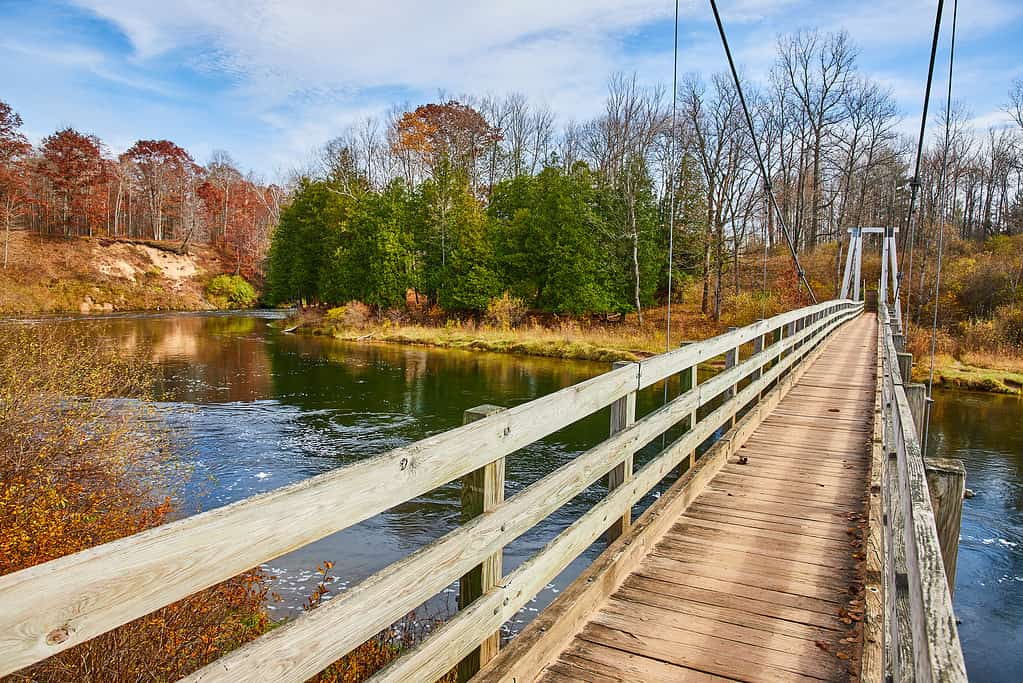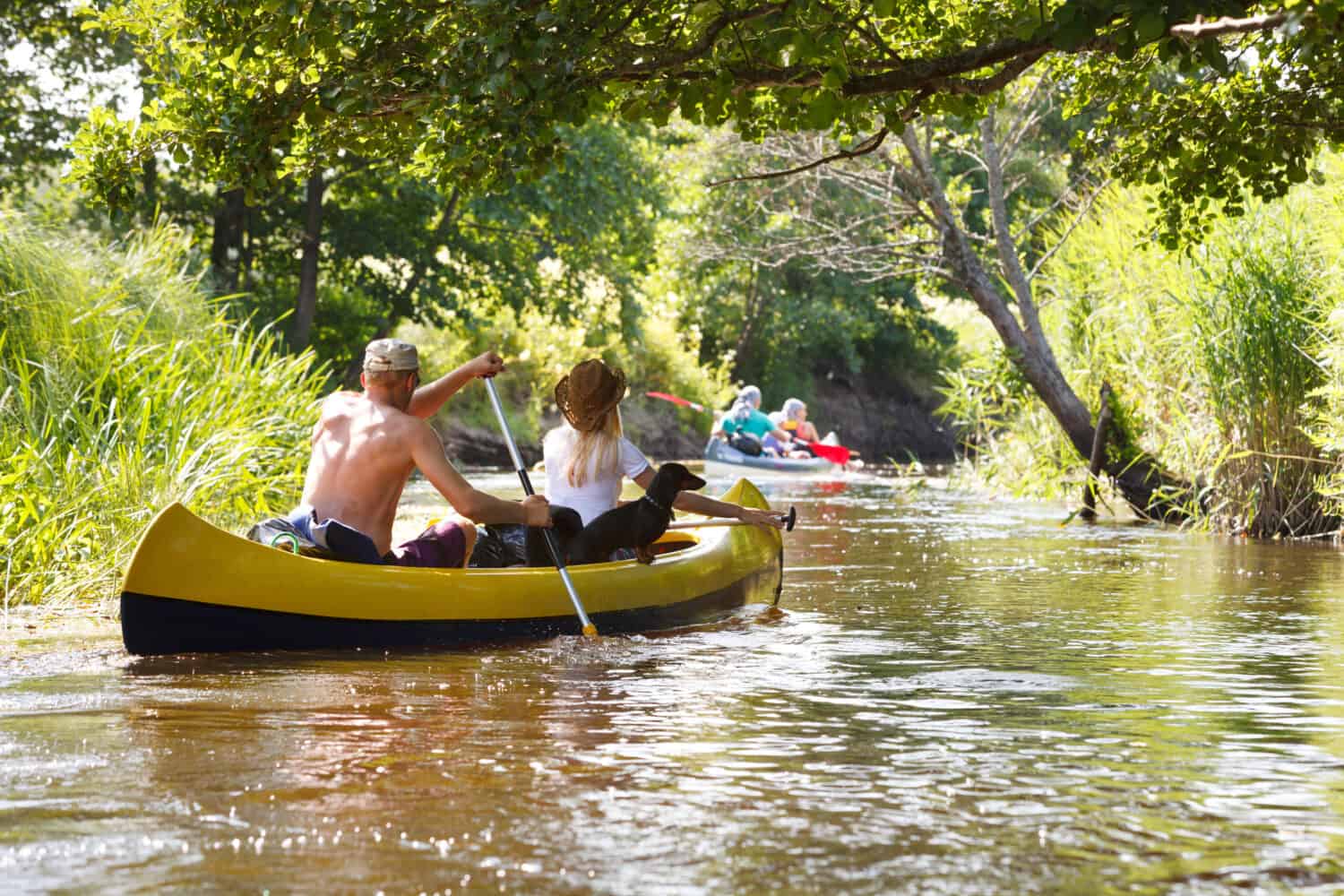As Laura Gilpin said, “A river seems like a magic thing. Magic, moving, living part of the earth itself.” And, rivers are indeed magical. However, they can also be perilous if you’re not careful. From turbulent waters to dangerous creatures dwelling beneath the murky waters, some rivers can be downright treacherous.
Michigan has some beautiful rivers throughout the state. Kayaking, fishing, or lazily tubing down these waters can be fun activities for locals. However, not all of these rivers are safe for recreation. Read on to find out just how dangerous Michigan rivers are.
Drowning and Accident Statistics for Michigan Rivers

Michiganders, enjoying their kayaks on the Platte River, need to be aware of potential dangers on Michigan rivers.
©Sleeping Bear Dunes National Lakeshore / CC BY 2.0 – License
The state of Michigan is nestled among the Great Lakes, so most Michiganders understand how critical it is to be situationally aware while out on one of these lakes. However, people often underestimate the potential dangers of Michigan rivers. Even though rivers may appear calmer and smaller than the tempestuous waters of the Great Lakes, there are still potential risks.
American Whitewater’s accident database shows that, since 1997, there have been 21 drownings and 4 serious injuries in various Michigan rivers. Twenty-four of the incidents involved kayakers while one involved a man in an open canoe. Some of the drowning victims were caught in low-head dam hydraulics, while others had some kind of impact trauma. Many were not wearing life jackets.
Some Accidents Don’t End Up On the Report
However, not all of the injuries and drownings that have occurred in Michigan rivers have been recorded in American Whitewater’s database. Below are several of these incidents that weren’t recorded but were reported in local newspapers.
In August of 2023, a 49-year-old man was pulled from the Grand River after a search had been ongoing for days. The man had been struggling in the water and calling for help when a kayaker spotted him. Firefighters responded, but it was too late. Divers were sent to locate the man’s body, but he wasn’t found for several days.
In July of 2023, a 47-year-old man was found in the St. Joeseph’s River after a capsized canoe had been found by nearby Andrews University. The man was later identified.
In March of 2023, a 26-year-old man was found in the Tittabawasssee River. He had been missing since February when he disappeared while fishing.
In August of 2022, a man accidentally drowned in the Thunder Bay River. He had been trying to rescue his fiancee’s dog and slipped on rocks before going under. While his fiancee and her dog made it out of the river, the man drowned.
Also in August of 2022, a 40-year-old man accidentally drowned in the Allegheny River.
In June of 2020, a 24-year-old man jumped off a trestle over the Au Sable River. He didn’t know how to swim, so he drowned. Police suspected alcohol was involved.
Unfortunately, these injuries and fatalities often occur in rivers that originally seemed safe. People may feel comfortable getting into a kayak, canoe, or other type of boat without wearing a life jacket. They may even go boating or swimming alone, which instantly puts them at risk of accidental drowning. Many accidents could have been prevented with proper safety precautions.
What Makes Michigan Rivers Dangerous?

Dangerous currents aren’t always immediately obvious, making some Michigan rivers dangerous.
©Sandra Burm/Shutterstock.com
Currents and Dropoffs
Many of Michigan’s rivers have sandbars that change constantly. Even though the depth of the water on the downstream side of the sandbar may be just a few inches, it can quickly drop to several feet in just one step. Erosion can also cause sandbars to unexpectedly collapse, causing a steep dropoff.
Currents in rivers can be strong. Unfortunately, you often can’t see the current from the bank or from the shallow water at a sandbar’s edge. It’s not uncommon to be floating along gently until a powerful undercurrent takes your boat or body downstream.

It’s important to know the safe portion limit for the fish you eat.
©CSNafzger/Shutterstock.com
Fish
With over 11,000 rivers, streams, and lakes throughout Michigan, many people spend hours fishing in them. Sadly, some of these bodies of water have been tainted with various chemical pollutants such as mercury, PCBs, and dioxins. After a short while, the fish and aquatic life become poisoned with these toxins.
For many Michiganders, locally caught fish is a weekly meal. However, there is actually a prescribed intake amount per month based on a person’s weight and the type of fish eaten. Michigan has developed a statewide safe fish guidelines table to help people determine the safe amount of fish they should eat.

Along with chemical pollutants, cyanobacteria (blue-green algae) can produce cyanotoxins.
©Aleksandrkozak/Shutterstock.com
Pollution
Swimming is a fun summer recreation for many Michiganders because it doesn’t require expensive equipment. Even the strongest and most experienced swimmers, though, can’t protect themselves against the pollutants in the water. Studies have found that 95% of Michigan rivers and streams aren’t fit for swimming due to the amount of pollution in them.
When you swim, most often water ends up getting into your mouth. It’s almost inevitable. And, even if you don’t swallow water directly, it seeps into your skin’s many pores. Therefore, with the 54,000 miles of Michigan rivers and streams containing bacteria, nitrates, and other contaminants, swimmers are at risk of ingesting or absorbing these toxins.

Black bears, though usually shy, can be dangerous if caught off guard or if they feel threatened.
©Mark Caunt/Shutterstock.com
Dangerous Wildlife Around Michigan’s Rivers
Michigan residents are typically used to looking out for wildlife when they’re in the woods. But, did you know that the river holds some dangerous wildlife, too? The black bear is one of these potential dangers. Bears love fish, so you can often find them dipping their big paws into a river, searching for a meal. Although black bears are typically shy, you wouldn’t want to run into one close-up.
Another potentially threatening animal is the snapping turtle. Some of these creatures grow up to 14 inches and weigh as much as 45 pounds. Their bite can take off some fingers — possibly even a whole hand.
Other creatures to be wary of are the Eastern Massasauga rattlesnake and the pesky mosquito, which can be found in and around wetlands. Though not common, people in Michigan have stumbled upon rattlesnakes while out on the river. Contrary to the Massasauga rattlesnake, mosquitoes are all too common, and they can carry diseases. Wearing insect repellent is a wise choice when on the river.
What Are the Most Dangerous Rivers in Michigan?

Despite the picturesque setting of the Manistee River, it holds inherent dangers for anyone caught off guard.
©Nicholas Klein/iStock via Getty Images
Any river has the potential to be dangerous. That’s why it’s important to always use caution when participating in any water activity. There are some Michigan rivers in particular that are even more dangerous than others.
The Manistee River
Outdoor enthusiasts are often drawn to the Manistee River due to its stunning scenery and diverse wildlife. Consequently, the idyllic setting can catch these people unaware. Below the deceptive surface, the river holds the dangers of swift currents, and difficult rapids can quickly overturn kayaks and canoes.
The Au Sable River
The Au Sable River is a beautiful, gently flowing river that looks so inviting. With its verdant trees and plants adorning its bank, it can be a misleading lure for kayakers, canoeists, and fishermen alike. Nonetheless, underneath the calm waters lie strong undercurrents that have claimed the lives of boaters and swimmers alike. Sudden dropoffs also create treacherous conditions for those visiting the river.
The Sturgeon River
Adventurers often flock to the Sturgeon River for white-water amusement. Sometimes, though, they get more than they bargained for in this unpredictable river. Only very skilled boaters should attempt to navigate the Sturgeon River with its challenging rapids, craggy rocks, unforeseen twists and bends, and violent eddies. Even those skilled boaters are taking a risk on this river.
The Grand River
This river is Michigan’s longest, flowing for 252 miles. With heavy rainfall, rising waters and flooding can be fatal to river-goers. Strong and swift currents and sudden dropoffs are also dangers of which you need to be aware. Underneath the water, objects that have been submerged and become obstacles cause risks as well.
The Rifle River
Each year, the Rifle River fills with locals and tourists for its infamous sucker fishing. Others enjoy boating and swimming in this seemingly peaceful and gorgeous river. Even so, there are hidden dangers in and under the water. There are sandbars that change all the time, undertows, and unpredictable surges. Anyone who spends time in the Rifle River needs to be careful and aware of the surroundings.
Staying Safe on Michigan Rivers

It’s important to use caution when kayaking, canoeing, or swimming in one of Michigan’s Rivers.
©Inc/Shutterstock.com
Michigan rivers can provide an abundance of recreational opportunities for Michiganders and visitors alike. Fishing, swimming, kayaking, and canoeing are just some of the fun experiences to be had. However, it’s critical to use caution and forethought before diving into one of these aquatic adventures. Read on for some safety tips.
Personal Flotation Devices (PFD)
Always, always, always wear a life preserver and have lifesaving flotation devices available in your boat. Despite being a strong swimmer or experienced boater, Michigan rivers have claimed numerous lives because of unexpected dangers. Even if a strong current ends up pulling you in, the life preserver can keep you safe.
Use the Buddy System
Swimming alone in any situation is dangerous. If you’re spending time in any of Michigan’s rivers, it’s important to have at least one other person with you. If you’re suddenly pulled under the or have a sudden health issue on the water, the other person can either rescue you or call for help.
Follow Water and Weather Advisories
First of all, never, ever swim in a river with a no swimming posting. Secondly, listen to weather conditions before setting off for a river adventure. Recent heavy rainfall can cause river levels to rise and flood. Or, bacteria levels in a certain area could be dangerously high. Finally, stay out of the river if the weather is stormy enough to cause turbulence in the water or if it’s lightning.
Feet First
Rivers are full of jagged rocks, submerged obstacles, and other hidden dangers. Never dive in head-first, especially from a height. If your head strikes a rock or hard object, it could cause a concussion, make you lose consciousness, or even cause paralysis or death. Even just a small concussion could lead to accidental drowning.
Stay Sober
Drinking and boating can be potentially fatal to you and to others on the river. Swimming under the influence of alcohol can also cause potential drowning. It’s vital to stay sober when you’re in and on any of Michigan’s rivers. It’s also important to remember that boating while under the influence of alcohol is a misdemeanor with potential jail time and a fine.
Learn to Swim
Living in Michigan means living near the water for most residents. Everyone who plans to swim or engage in other water recreation should learn how to swim. If you have children, it’s critical to have them learn to swim, preferably from a Red Cross swim lesson provider.
How Dangerous Are Michigan Rivers?
All Michigan rivers can be dangerous if you aren’t prepared. But they can also provide hours of fun and recreation if you follow the above safety tips. The rivers in Michigan are beautiful, but you have to respect their power and inherent dangers.
The photo featured at the top of this post is © Ryan Kashmark/Shutterstock.com
Thank you for reading! Have some feedback for us? Contact the AZ Animals editorial team.







